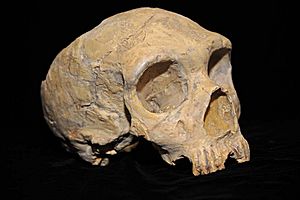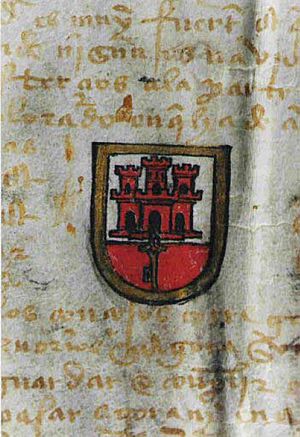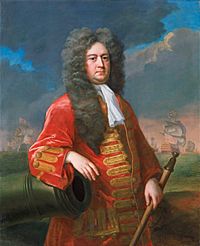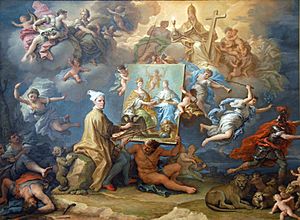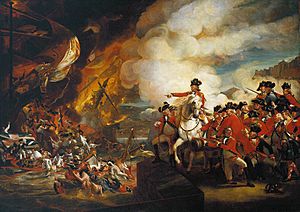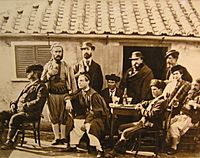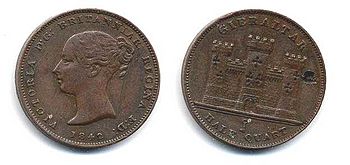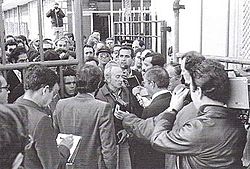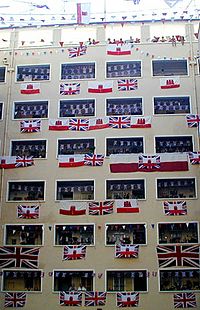Timeline of the history of Gibraltar facts for kids
The history of Gibraltar shows how this small place, known as The Rock, became super important and famous. It has shaped the lives of many people who have lived there over hundreds of years.
Contents
Ancient Times: Early People and Visitors
Long, long ago, even before modern humans, Neanderthals lived on the Rock! Scientists found a Neanderthal skull in Forbes' Quarry way back in 1848. This was even before the famous discovery in Germany that gave Neanderthals their name. Later, in 1926, another skull, this time from a Neanderthal child, was found in Devil's Tower Cave.
Evidence suggests that Gibraltar might have been one of the very last places where Neanderthals lived, as recently as 24,000 to 28,000 years ago. After them, modern humans started visiting the area.
Back then, Gibraltar was like a wild safari park! Leopards, hyenas, wolves, and bears roamed alongside wild cattle, horses, and rhinos. There were also olive trees, pine trees, and lots of birds and shellfish. This rich environment probably helped the Neanderthals survive for a very long time, maybe even 100,000 years! Later, around 24,000 BCE, a group of early modern humans called Cro-Magnons took over Gibraltar.
Early Sailors and Empires
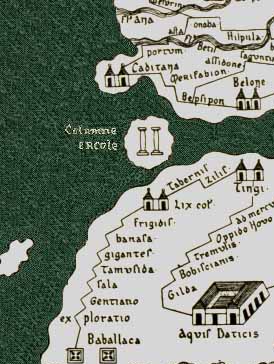
Around 950 BC, the Phoenicians, who were great sailors, visited the Rock and called it "Calpe". The Carthaginians also came by. But it seems neither group stayed for good. The ancient Greek thinker Plato even mentioned Gibraltar as one of the Pillars of Hercules, along with a mountain across the strait in Africa.
The Romans also visited Gibraltar, but they didn't build a lasting settlement. After the big Roman Empire in the West ended, different groups like the Vandals and then the Goths took control of the Iberian peninsula (Spain and Portugal). Gibraltar was part of the Byzantine Empire for a while in the 500s, before going back to the Goths.
Muslim Rule: A New Name and Strongholds
- 711 – A general named Tariq ibn Ziyad, leading an army mostly made up of Berbers, sailed across the Strait from Africa. He landed at the southern tip of the Rock. This is how Gibraltar got its name: Gabal-Al-Tariq, which means "Tariq's Mountain" in Arabic. Not much was built here for the first 400 years of Moorish (Muslim) control.
- 1160 – The Sultan Abd al-Mu'min ordered a proper town and a castle to be built. It was called Medinat al-Fath, meaning "City of Victory." Part of this castle, the Tower of Homage, is still standing today and is known as the Moorish Castle.
- 1231 – After the Almohad Empire fell apart, Gibraltar was taken over by Ibn Hud, a local ruler.
- 1237 – Gibraltar changed hands again, becoming part of the Nasrid kingdom of Granada.
- 1274 – The Nasrids gave Gibraltar to the Marinids, another Muslim group, as payment for their help in wars.
Battles for Control
- 1309 – The Castilians (from a Christian kingdom in Spain) captured Gibraltar after a month-long fight. This was the First Siege of Gibraltar. About 1,500 people lived there then.
- 1310 – King Ferdinand IV of Castile gave Gibraltar its first official rules, called a Charter. This made it a council town and offered special benefits to people who lived there.
- 1333 – The Marinids took Gibraltar back after a five-month siege. King Alfonso XI of Castile tried to get it back but had to agree to a truce, letting the Marinids keep it.
- 1344 – Nearby Algeciras was captured by the Castilians. This made Gibraltar the main Marinid port in the area.
- 1349-1350 – King Alfonso XI tried to capture Gibraltar again, but he failed. The second attempt was stopped by the terrible Black Death plague, which killed many of his soldiers, including the king himself.
- 1374 – Gibraltar was given back to the Nasrids of Granada.
- 1411 – The Nasrids took Gibraltar back after a rebellion.
- 1436 – A Castilian count tried to attack Gibraltar but was defeated.
Castilian/Spanish Rule: A Royal Town
- 1462 – Castilian forces finally captured Gibraltar again. This led to arguments between two powerful Spanish families over who would own the town. King Henry IV of Castile decided Gibraltar would belong to the Crown (the king), not a private family. He gave Gibraltar special rights and made its main church a "collegiate church." Saint Bernard became Gibraltar's patron saint.
- 1463 – King Henry IV was the first Christian king to visit Gibraltar.
- 1467 – During a rebellion against the king, the Duke of Medina Sidonia took Gibraltar after a long siege.
- 1469 – The Duke of Medina Sidonia changed sides and was rewarded by Queen Isabella I of Castile, who confirmed Gibraltar was part of his lands.
- 1478 – The Duke of Medina Sidonia was given the title of Marquis of Gibraltar.
- 1479 – Queen Isabella I and King Ferdinand II of Aragon, known as the Catholic Monarchs, began to rule both Castile and Aragon, including Gibraltar.
- 1492 – After conquering Granada, the Catholic Monarchs ordered all Jews to leave Spain. Many passed through Gibraltar on their way to North Africa.
- 1501 – The Catholic Monarchs recognized how important Gibraltar was and asked the Duke of Medina Sidonia to return it to the Crown. He agreed.
- 1502 – Gibraltar was officially given its own coat of arms by Queen Isabella I. It shows a castle with a key hanging from it, symbolizing Gibraltar's role as the "key" to the Strait. This castle and key are still on Gibraltar's arms today.
- 1506 – The Duke of Medina Sidonia tried to take Gibraltar back, but his siege failed. The town was then given the title "Most Loyal City."
- 1516 – Spain became a united kingdom under King Charles I.
- 1540 – Pirates from North Africa, led by Barbarossa, attacked Gibraltar, looting the town and taking many people captive.
- 1552 – To make Gibraltar safer, King Charles I sent an engineer to build stronger defenses, including a wall known today as the Charles V Wall.
- 1567 – Juan Mateos turned his large house into Gibraltar's first hospital, which served the people for centuries.
- 1606 – Many Moriscos (descendants of Muslims in Spain) were forced to leave Spain by King Philip III. Many passed through Gibraltar on their way to North Africa.
- 1607 – During a war between the Dutch and Spain, a Dutch fleet surprised and attacked a Spanish fleet in the Bay of Gibraltar in the Battle of Gibraltar.
- 1649 – A serious illness, a typhoid epidemic, spread through the town.
- 1656 – Oliver Cromwell, a powerful leader in England, thought Gibraltar would be a good permanent naval base at the entrance to the Mediterranean Sea.
The War of the Spanish Succession: A New Era
- 1700 – King Charles II of Spain died without children. He left his kingdom to Prince Philip of Bourbon, who was supported by France. Other European powers, including England and the Netherlands, supported a different claimant, Archduke Charles. This disagreement led to a big war.
- 1702 – The War of the Spanish Succession officially began.
The Capture of Gibraltar
- 1704 August 4 – During the war, an Anglo-Dutch fleet, led by Sir George Rooke, attacked Gibraltar. They demanded that the Spanish governor surrender. The governor, Diego de Salinas, refused. A large force of British and Dutch Marines, led by Prince George of Hesse-Darmstadt, then began to attack the town.
- 1704 August 4 – After heavy shelling, Governor Diego de Salinas surrendered Gibraltar to Prince George of Hesse. Prince George claimed it for Archduke Charles.
- 1704 August 7 – Most of the Spanish people living in Gibraltar, along with the Spanish soldiers and officials, left the town. They took important historical items with them and settled nearby in a new town called San Roque. Only about 70 people stayed in Gibraltar, mostly religious people or traders from Genoa.
- 1704 August 24 – The Alliance fleet, after leaving Gibraltar, fought a Spanish-French fleet near Málaga. This battle stopped the Spanish-French fleet from reaching Gibraltar.
The First Spanish Siege
- 1704 September 5 – French and Spanish troops, led by the Marquis of Villadarias, began a siege to try and take Gibraltar back. The British and Dutch Marines, led by Prince George of Hesse-Darmstadt, defended the fortress.
- 1704 November 11 – A group of 500 Spanish volunteers tried to surprise the defenders by climbing up the Rock using a secret path. But they were stopped by Captain Fisher and his Marines.
- 1705 March 31 – The French and Spanish forces gave up the siege and left.
During the Rest of the War
Even though Gibraltar was officially held for Archduke Charles, Britain started to take more control.
- 1705 August 2 – Archduke Charles visited Gibraltar. He appointed the English Major General John Shrimpton as governor.
- 1706 February 17 – Queen Anne of Great Britain declared Gibraltar a "free port," meaning ships could trade there without special taxes.
- 1707 December 24 – The first British Governor, Roger Elliott, appointed directly by Queen Anne, moved into the Franciscan friars' building, which is now known as The Convent.
British Rule: A Permanent Change
The Treaty of Utrecht
- 1713 April 11 – The Treaty of Utrecht was signed, ending the War of the Spanish Succession. In this treaty, Spain officially gave Gibraltar to the Crown of Great Britain "forever." This meant Gibraltar would always belong to Britain.
- The treaty said that no trade should happen between Gibraltar and Spain by land, except for emergency food if Gibraltar couldn't get supplies by sea. It also said that Jews or Moors (Muslims) should not live in Gibraltar. However, this rule was not followed for long, and Gibraltar has had Jewish and Muslim communities for many years.
- Another important part of the treaty was that if Britain ever wanted to give up Gibraltar, Spain should be offered it first.
Challenges and Sieges
- 1721 – King Philip V of Spain asked for Gibraltar back. King George I of Britain said he would try to arrange it with his Parliament, but Parliament never agreed.
- 1727 February–June – Spain tried to recapture Gibraltar again in a five-month siege. Spanish troops were much larger in number, but the British defenders held strong, and Spain eventually gave up.
- 1729 – The Treaty of Seville confirmed that Britain would keep Gibraltar.
- 1730 – Spain built new forts across the narrow strip of land connecting Gibraltar to Spain. These forts were the start of the modern-day town of La Línea de la Concepción.
- 1749–1754 – Governor Humphrey Bland set up rules for Gibraltar. One rule said that only Protestants could own property. By 1754, about 6,000 people lived in Gibraltar, mostly soldiers and their families, but also many Genoese and Jewish civilians.
- 1779 June – Spain declared war on Great Britain during the American Revolutionary War.
- 1779 July – The Great Siege of Gibraltar began. This was a huge effort by French and Spanish forces to take Gibraltar from the British. The British soldiers, led by General George Augustus Eliott, bravely defended the Rock against all attacks and a blockade that cut off supplies.
- 1782 September 13 – A massive assault involving 100,000 men, 48 ships, and 450 cannons failed to defeat the British garrison.
- 1783 February – The siege ended. General Eliott was honored for his leadership. The Treaties of Versailles confirmed that Gibraltar would remain British.
- During the Great Siege, work began on the Great Siege Tunnels, a complex system of underground tunnels and fortifications inside the Rock. These tunnels are still there today. The successful defense of Gibraltar made it a symbol of strength and bravery in Britain.
19th and Early 20th Centuries
- 1800 – Britain took control of Malta. Having both Gibraltar and Malta gave the British Navy great control over the Mediterranean Sea.
- 1804 – A terrible epidemic, probably typhus, broke out in Gibraltar, killing nearly 5,000 people.
- 1805 October 21 – The famous Battle of Trafalgar took place near Gibraltar.
- 1805 October 28 – Admiral Nelson's ship, HMS Victory, was towed into Gibraltar with his body on board after the battle. The Trafalgar Cemetery in Gibraltar is still there today.
- 1810 – Britain and Spain became allies against Napoleon. The Governor of Gibraltar ordered the Spanish forts on the northern border to be blown up, fearing they might fall into French hands.
- During the Peninsular War, Gibraltar became a supply base and a safe place for Spanish forces fighting against the French.
- 1815 – Gibraltar's civilian population grew to about 10,000 people, much larger than the military garrison. Many immigrants from Genoa, Spain, Portugal, and Morocco had arrived.
- 1830 – The British government changed Gibraltar's status to a "Crown Colony." This meant its administration moved from the military to a civilian office. New legal systems and the Gibraltar Police Force were created.
- 1842 – The Church of England created the Diocese of Gibraltar, and the Church of the Holy Trinity became its main church. Official coins were also made for Gibraltar by the Royal Mint.
- 1869 – The Suez Canal opened, making Gibraltar even more important as a stopping point on the route from the UK to India. Gibraltar's economy grew with new coaling stations for steamships.
- 1908 – Britain built a fence along the border with Spain to help stop smuggling. Spain still doesn't fully recognize this fence as the official border. Even though Spain, the UK, and Gibraltar are all part of the European Union, the border is still important because Gibraltar is outside the EU's customs union.
- 1921 – Gibraltar was given "City Council" status for its help in World War I.
- 1936–1939 – During the Spanish Civil War, Gibraltar saw several incidents, including British ships being damaged by mines and German ships arriving with wounded sailors.
Second World War and Beyond
- During World War II (1939–1945), Gibraltar became a strong fortress again. Most civilians were moved away for safety. Many went to Britain, Madeira, or Jamaica. Gibraltar was vital for the Allied Powers because it controlled the entrance to the Mediterranean Sea. It was a key supply base and a base for the British Navy. An airbase was built on the narrow strip of land.
- 1940 July 4 – French bombers attacked Gibraltar in revenge for the British Navy destroying French ships in Algeria.
- 1941 – Germany planned to invade Gibraltar in "Operation Felix," but it was canceled because Spain was unwilling to let German troops enter its territory to attack Gibraltar.
- 1940–1943 – Italian frogmen (underwater commandos) attacked Gibraltar's harbor many times.
- 1942 September – A group of Gibraltarians formed 'The Gibraltarians Association,' which later became the Association for the Advancement of Civil Rights (AACR), Gibraltar's first political party.
- 1944 April – Civilians began to return to Gibraltar. The experience of being evacuated helped Gibraltarians feel more like a united nation.
- 1954 – Queen Elizabeth II visited Gibraltar to celebrate 250 years of British rule. This angered General Franco, the leader of Spain, who renewed Spain's claim to Gibraltar. This led to Spain closing its consulate and restricting movement across the border.
- 1955 – Spain brought its claim to Gibraltar to the United Nations, arguing that Gibraltar should be returned to Spain.
- 1967 – Gibraltar held its first vote on its future. People were asked if they wanted to be Spanish or remain British with self-government. Over 99% voted to stay British.
- 1969 May 30 – A new constitution was introduced, giving Gibraltar full internal self-government. The constitution stated that Gibraltar would never become part of another country against the wishes of its people.
- 1969 June 8 – In response to the new constitution, Spain completely closed its border with Gibraltar and cut off all communication links. This lasted for about 13 years, trying to isolate Gibraltar. Many Spanish workers lost their jobs in Gibraltar.
- 1973 – Gibraltar joined the European Economic Community (now the European Union) along with the United Kingdom.
- 1975 – Spanish dictator General Francisco Franco died, but the border remained closed.
- 1980 April 10 – Britain and Spain signed the Lisbon Agreement, agreeing to reopen communications, but the measures were not put into action right away.
- 1981 – A new British law changed Gibraltar's status to a "Dependent Territory." After a campaign, Gibraltarians were given full British citizenship.
- 1982 December 15 – The border was partially reopened, allowing pedestrians to cross. Full reopening came later.
- 1984 – Spain applied to join the European Community. Britain and Spain agreed to talk about Gibraltar, including the issue of sovereignty. The border was fully reopened.
- 1987 December 2 – A plan for Spain and Britain to jointly control Gibraltar Airport was met with strong opposition in Gibraltar.
- 1988 – Joe Bossano became Chief Minister and firmly rejected any talks with Spain about sovereignty or sharing the airport.
- 1991 – The British Army largely left Gibraltar, leaving only the local Royal Gibraltar Regiment. Spain made new proposals for shared sovereignty, but these were rejected by Gibraltar's leaders.
- 1996 – Peter Caruana became Chief Minister. He favored talking with Spain but also ruled out any deals on sovereignty.
- 2000 – An agreement was made between the UK and Spain to recognize Gibraltar's government departments and documents.
- 2001 – The UK government announced plans for shared sovereignty with Spain, but Gibraltarians strongly opposed this.
- 2002 – The UK Foreign Secretary, Jack Straw, stated that Britain and Spain were close to an agreement on shared sovereignty. However, Gibraltar held its second vote on the proposal. A massive 98.97% of voters rejected the idea of shared sovereignty.
- 2004 August – Gibraltar celebrated 300 years of British rule. Spain called this a celebration of "300 years of British occupation."
- 2006 September 18 – The Córdoba Agreement was signed by British and Spanish foreign ministers and Gibraltar's Chief Minister. This was a big step! It included:
- Spain recognizing Gibraltar's international phone code.
- Removing Spanish restrictions on flights at Gibraltar Airport, and building a new terminal.
- Normal traffic flow at the border.
- Britain paying pensions to Spanish citizens who lost jobs when the border closed in 1969.
- An Instituto Cervantes (Spanish cultural center) opening in Gibraltar.
- 2006 November – A new constitution was approved by the people of Gibraltar in a vote. Britain and Gibraltar described it as non-colonial.
- 2007 February 10 – Spain lifted restrictions on Gibraltar's phone systems.
- 2008 June 18 – Gibraltar's Chief Minister, Peter Caruana, stated that Gibraltar no longer needed the UN Committee on Decolonization to help with its self-rule.
- 2009 December 12 – Miss Gibraltar, Kaiane Aldorino, won the title of Miss World! Her return home was a huge public celebration.
- 2009 December 17 – A ferry service between Gibraltar and Algeciras restarted after 40 years.
- 2011 – The GSLP / Liberal Alliance won the election, and Fabian Picardo became Chief Minister.
- 2016 – About 80% of Gibraltar's voters wanted to stay in the European Union in the UK's referendum.
- 2020 – When Britain left the EU, Gibraltar became foreign territory to the EU. However, a preliminary agreement was made to avoid a hard border between Gibraltar and Spain, with more talks planned for the future.
See also


